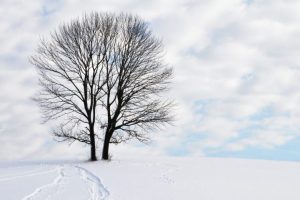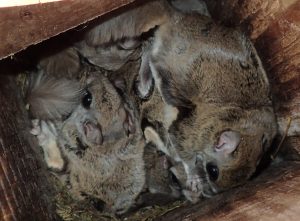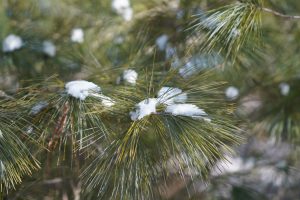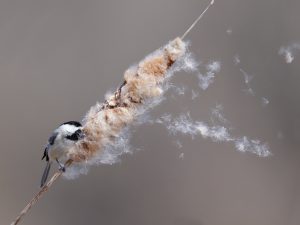The Alive of Winter
Bats do it. Groundhogs do it. Even several jumping mice do it.

Hibernation — when respiration and heartbeat slow dramatically and body temperature falls to near freezing — is just one of many adaptations among plants and animals to enable cold-weather survival. Let’s take a look beneath the stillness of winter at some fascinating processes at work and get some cold truths from a warming planet.
Who Hibernates?
Many of us were taught that bears hibernate in winter, and that’s our primary image of animals during this season. In fact, only a few of Pennsylvania’s native species are true hibernators: the groundhog, woodland mouse, meadow jumping mouse, and all 11 bats common to the state.
Instead, many animals enter a state of torpor, when their activity, heart rate and breathing slow to conserve energy. Black bears, chipmunks, skunks and raccoons all employ this strategy.

Several species of frogs, including the common Wood Frog, go beyond torpor or hibernation and spend winters frozen alive. As temperatures plummet, water flows out of the frog’s internal organs, eventually forming a protective layer of ice. Meanwhile, its body accumulates urea and glucose, which act as an antifreeze, keeping individual cells in vital organs from freezing.
Other animals employ teamwork, huddling or denning to share body heat. Flying squirrels seek refuge together in leafy nests high in trees, beavers curl up in lodges insulated by mud, and snakes coil together in dens located below the frostline to wait for spring.
Songbirds that overwinter in our region rather than migrating to warmer climes spend especially cold nights piled together in a hollow tree cavity or empty nest box. During the day, they puff up their feathers to trap more heated air. Birds also have the unique ability to use a countercurrent heat exchange, isolating the blood that flows in their legs rather than circulating it throughout their entire bodies.
Active Animals
Of course, animals that aren’t dormant must continue to find food to replenish the additional energy required to keep warm. Songbirds rely on essential winter nutrition from seeds, insects, spiders and spider eggs, which they find under bark, in the ground, or even frozen on tree branches awaiting spring.

Other animals stockpile food stores during autumn. Eastern Gray Squirrels first check acorns for weevils or other boring beetles, eating those affected nuts on the spot because those nuts would rot and spoil the winter stashes. One squirrel can create 1,000 caches in a year’s time. Thanks to their extraordinary sense of smell and memory, these remarkable rodents recover about 80% of the food they’ve “squirreled away.” The remainder is left to grow into oak and beech trees.
Red-headed Woodpeckers wedge seeds, nuts and even captured insects into tree bark, creating “granaries” that can store thousands of items. Woodpeckers also cache food in gate posts, railroad ties and under house shingles, hammering their finds into crevices so tightly that other animals are unable to remove them.
Greener Pastures
Plants have decidedly fewer options than animals when it comes to winter survival. Deciduous trees drop their leaves in fall, shedding themselves of this winter liability. Leaves are used for photosynthesis — absorbing sunlight through chlorophyll and converting it to energy. They also release water, creating a hydrostatic pressure difference that causes tree roots to draw water from the soil. As trees enter dormancy, their demands for water and nutrients — and the leaves that regulate them — drop.
Conversely, evergreen trees and shrubs have adapted to keep their leaves and needles. This means they grow year-round, even during winter, as they continue to photosynthesize.

Needles, like those on white pine trees, are covered in a waxy coating that helps the plant retain moisture in dry winter months. These needles aren’t tasty to hungry winter animals unless they’re desperate. And the long, narrow shape means needles — even when coated in snow or ice — are less likely than broad leaves to catch the wind and damage the tree.
As spring rolls around, woody plants must “decide” when to resume growing. If they emerge from dormancy too soon, they face damage from frost — too late and they miss taking advantage of the full growing season. Trees and shrubs have built-in warming and light requirements, triggering leaves to grow only after a certain number of days of warmth and sunlight.
It’s easy to understand how many plant species, so dependent on these seasonal signals, are being impacted by our rapidly changing climate. As spring temperatures get warmer than in the past, trees may respond by leafing out and flowering weeks earlier than normal, increasing their vulnerability to late frosts.
Cold Truths from a Warming Planet
Animals have three options in the face of climate change: adapt, move or perish.
One Pennsylvania species on the move is the once-ubiquitous Black-capped Chickadee, which is no longer found in the southeastern part of the state. Instead, the Carolina Chickadee, once considered a southern species, has taken its place.

Scientists have identified a zone where the ranges of these two chickadees overlap, and it’s moving north at about 0.7 miles per year. In fact, the scientists who first studied the phenomenon — Robert Curry of Villanova University and Scott Taylor of Cornell Lab of Ornithology — ended up adding another site to their study in Schuylkill County, PA, to keep up with the rapid northward movement of these birds.
“The rapidity with which these changes are happening is a big deal,” Scott Taylor said in Current Biology. “If we can see it happening with chickadees, which are pretty mobile, we should think more closely about what’s happening to other species. Small mammals, insects and definitely plants are probably feeling these same pressures — they’re just not as able to move in response.”
A Cautionary Tale
According to a report by World Wildlife Fund, some bird species now arrive in spring breeding grounds earlier.
This can have devastating consequences if sufficient food isn’t available then. Consider the Red Knot, a federally “threatened” species since 2014.
Every February, the Red Knots leave their winter home at the far tip of South America. They work their way north along the coast until they make it to Brazil when, flying in flocks of thousands, they travel across the Atlantic Ocean to their Arctic breeding grounds.

The birds make a critical stopover at the Delaware Bay to refuel before continuing. An estimated 90% of the entire species population can be found on the Bay — including at Raybin’s Beach in Natural Lands’ Glades Wildlife Refuge — in a single day. The birds spend two weeks feeding before resuming their migration to the Arctic Circle.
A key component of the Red Knot diet is the eggs of Atlantic horseshoe crabs, whose spring spawn on the moonlit beaches has always timed perfectly with the Red Knots’ arrival. The crab eggs, full of fat and protein, are the ideal fuel for hungry Red Knots, which have lost up to half their body weight by the time they arrive at Delaware Bay.
“It’s a remarkable sight when they arrive by the thousands,” said Brian Johnson, preserve manager at Glades Wildlife Refuge and avid birder. “Their migration route is one of the longest in the avian world, and timing for each leg of their trip is critical. It would be heartbreaking to think they may arrive too soon and not have enough to eat when they get here.”
Natural Lands is dedicated to preserving and nurturing nature’s wonders while creating opportunities for joy and discovery in the outdoors for everyone. As the Greater Philadelphia region’s oldest and largest land conservation organization, member-supported Natural Lands has preserved more than 125,000 acres, including 42 nature preserves and one public garden. Nearly 5 million people live within 5 miles of land under Natural Lands protection. Land for life, nature for all. NatLands.org.
